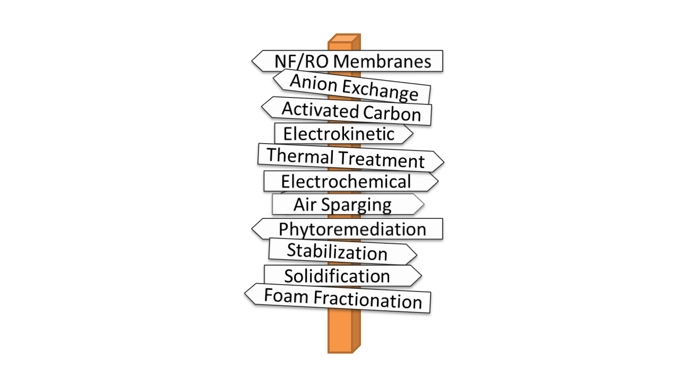
PFAS treatment methods
KEY POINTS- PFAS
- Treatment
- Environment
Project overview
Participants
More related research
Global goals
- 3. Good health and well-being
- 6. Clean water and sanitation
- 14. Life below water
- 15. Life on land
Short summary
Research on per- and polyfluoroalkyl substances (PFAS) treatment focuses on effective strategies to remove these persistent pollutants from the environment. This overview highlights pilot- and full-scale techniques tested to address PFAS contamination.
Our treatment strategy is focused on developing tailored treatment trains built around three core elements: (1) separation, (2) concentration, and (3) destruction. Each component is designed to target specific PFAS, and the approach is adapted to suit the unique characteristics of the location and environmental matrices involved.
Treatment methods assessed in our research activities
Water treatment methods
- Foam Fractionation: Uses air bubbles to concentrate PFAS into a foam layer for separation from water
- Membrane Treatment: Physically filters PFAS through nanofiltration or reverse osmosis membranes, producing clean water and PFAS-rich brine
- Phytoremediation: Employs plants to absorb and store PFAS from contaminated soil or water, offering low-impact removal
- Granular Activated Carbon (GAC): Adsorbs PFAS onto porous carbon surfaces, commonly used in drinking water filtration
- Anion Exchange: Uses charged resin beads to attract and capture PFAS based on their negative charge and hydrophobic properties
- New Materials: Advanced engineered materials like Metal–Organic Frameworks (MOFs) and Covalent Organic Frameworks (COFs) selectively adsorb PFAS and sometimes enable detection or destruction
- Electrochemical Oxidation: Applies electric current to degrade PFAS molecules through reactive species generated at the electrodes
- Microbial Degradation: Investigates bacteria and enzymes to biologically break down PFAS, although most current methods are still experimental and more research is needed
Solid material remediation
- Phytoremediation: Uses plants to absorb PFAS from contaminated soil, offering an eco-friendly but slow removal option
- Soil Stabilization: Adds materials like activated carbon to soil to immobilize PFAS and prevent leaching
- Soil Stabilization and Solidification: Combines chemical binders and physical encapsulation to lock PFAS in place and improve soil integrity
- Electrodialytic Remediation: Applies an electric field to mobilize and extract PFAS ions from soil via electrolyte solutions
- Air Sparging: Injects air into soil to mobilize PFAS, which can be used with foam recovery systems
- Thermal Treatment: Heats soil to high temperatures to mobilize or break down PFAS through thermal desorption or destruction
- Microbial Degradation: Investigates bacteria and enzymes to biologically break down PFAS, although most current methods are still experimental and more research is needed
Current projects on PFAS treatment methods
- LIFE SOuRCE: Demonstration and evaluation of Sustainable On-site Remediation technologies for PFAS-ContaminatEd groundwater (co-applicant, WP leader)
- LIFE CAPTURE: Combining novel analytical protocols for PFAS contamination with technologies for sustainable remediation (co-applicant, WP co-leader)
- SIDWater: Sustainable innovative drinking water treatment solutions for large-scale water supply and reuse, Formas (PI Lutz Ahrens)
- PFASMAR: Artificial groundwater recharge – A shortcut for harmful poly- and perfluoroalkyl substances (PFASs) into groundwater systems and drinking water supplies – Can we avoid this? Formas (PI Philipp Wanner, GU)
- DRICKS: Competence centre for drinking water - Projects about Sources, prevalence, and treatment of hazardous chemicals in drinking water, Svenskt Vatten and others
- Remediation of PFAS-contaminated soil using air sparging, SGU and SGI (PI Lutz Ahrens)
- BioPFAS: Microbial degradation of PFAS for remediation of contaminated soil and groundwater, SGI Tuffo (PI Fritjof Fagerlund, Uppsala University)
Finalized projects on PFAS treatment methods
- PhytoRem: Phytoremediation of per- and polyfluoroalkyl Substance (PFAS)-contaminated soil and groundwater, SGI Tuffo (PI Lutz Ahrens)
- A novel approach for the removal of per- and polyfluoroalkyl substances (PFASs) in drinking water by engineering metal-organic and covalent organic frameworks, Formas (PI Lars Öhrström, Chalmers)
- Rest to best: Biochar as solution and product in the circular and climate positive society, Vinnova (PI Lund municipality)
- Blackwater treatment and reuse as agricultural fertilizer, Formas (PI Meri Gros)
- ITN PERFORCE3: Per- and polyfluorinated alkyl substances towards the future of research and its communication in Europe (Coordinator Ian T Cousins, ACES, Stockholm University, WP3 leader Lutz Ahrens)
- Food waste to new food in an urban context: Formas (PI Malin Hultberg, SLU)
LakePOPs: Lake Mälaren – a lake for millions – but threatened as a natural resource for drinking water, Formas (PI Karin Wiberg) - SafeDrink: Integrated chemical and toxicological methods for early detection of hazardous chemicals in drinking water, Formas (PI Karin Wiberg)
- RedMic: Novel strategies to reduce diffuse emissions of micropollutants from on-site sewage facilities, Formas (PI Patrik Andersson, Umeå University)
- PFASs-Free: Innovative treatment techniques for per- and polyfluoroalkyl substances in drinking water, Formas (PI Lutz Ahrens)
- PFASs-PURE: Innovative treatment techniques for per- and polyfluoroalkyl substances in soil and groundwater, Vinnova (PI Lutz Ahrens)
- StopPFAS: In-situ remediation of PFASs based on sorption methods, SGI Tuffo (PI F Fagerlund, Uppsala University)
Publications